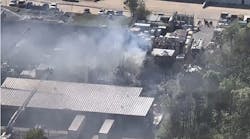The fire service has used various forms of ventilation at fires for decades with the belief that ventilation will lift smoke, which lets us search for victims, makes the environment more tenable for occupants and firefighters and makes getting the line into place easier. We have also used various forms of ventilation believing it will help control fire spread. A recent study published by Underwriter Laboratories, Impact of Ventilation on Fire Behavior in Legacy and Contemporary Construction, must make one question our ventilation evolution on the fireground (see Safety & Survival, “Fire Growth and Venting: What the Research Reveals,” in the March issue). Properly ventilating a fire is imperative. I experienced the impact of improper horizontal ventilation at a fire.
My truck company was dispatched to a fire a few blocks from the firehouse. The buildings in this part of our response district are mostly very large, ordinary-construction, historic, single-family residences. These are very big, ornate, graystone/limestone homes.
Enroute, we saw smoke down to the street, so we knew we had something. On arrival, we found just what we expected – a large, 2½-story, historic, limestone structure with heavy smoke showing. The building is set back from the street just far enough that our 100-foot aerial ladder could not reach the roof. (We were lucky the aerial didn’t make it because a portion of the roof collapsed very early in the incident).
We went to work. The lieutenant and two firefighters from the engine, with a charged hoseline, plus the lieutenant and a firefighter from my truck made entry through the front door to search for and extinguish the fire on the first floor. They encountered heavy smoke, which slowed their progress. To assist the entry team with their advancement, horizontal ventilation was initiated on the first floor. The roof team (which never made the roof) noted heavy smoke coming from the chimney and thought we might have a basement fire. The basement door was forced and windows were taken out, but the basement was found to be clear.
subhead
As companies continued operations on the first floor, we went into the building to do a primary search above the fire. We ascended a very wide decorative staircase to the second-floor hallway, where we encountered “lazy” fire burning on a wall, but very little heat. We started our search. The first bedroom, behind the burning wall, was clear – no fire, very light smoke and unoccupied. We continued to the second bedroom – again, no fire, light smoke and unoccupied. We continued to the third bedroom. The room was large, but clear.
All of a sudden, we heard windows breaking. Someone was venting the windows of the room from the outside. We felt a rush of fresh air, followed by rapidly increasing heat. We knew we needed to get out of there fast!
In the hallway, the fire on the wall was quickly growing in intensity due to the influx of fresh air, and the heat was becoming unbearable. Our ears were starting to burn under our hoods. The carpet we were crawling on melted to our pants and gloves. We reached the large stairwell we had ascended and made our way down to the landing, where we waited for a line while the fire and heat intensified. Another member brought in a 2½-inch line. The line was charged and we started to go after the fire. We felt we were making good progress because we made it back up to the hallway, but moments later, the chief ordered a complete evacuation of the building due to fire conditions he witnessed from outside. We went defensive. Three elevated master streams, multiple handlines and many hours later, the fire was out.
subhead
In the incident above, horizontal ventilation was done in an area of the building that was burning, but where there was no hoseline to counteract the effects of ventilation. The UL study substantiates what we experienced at that fire – we must be aware that poorly placed or untimely ventilation openings may increase air supply, causing rapid fire growth and fire spread that in turn may endanger occupants and firefighters. We must be very cautious when, where and how we ventilate.
We also must use a “coordinated fire attack,” the joint approach of the suppression team with the ventilation team and the coordination of ventilation with the placement and operation of the hoseline at the seat of the fire. The coordinated fire attack is important at all fires, but becomes vital when fires occur in larger structures and/or in structures that are overly segmented by walls, doors, partitions and shelving. The UL study showed that firefighters have only about 100 seconds to get water on the seat of the fire once ventilation occurs or the fire will expand exponentially. In larger or segmented structures, good communication is vital to ensure ventilation does not occur before the line is in proper position.
The typical single-family home is one to two stories high, with 700 to 3,000 square feet of floor space, and built of ordinary or frame construction. Fires frequently originate in kitchens and utility areas. Hoseline operations are relatively straightforward and even though each type of construction has its means of interior fire extension, the reflex time to counter the extension is short because the area is small. If the initial attack is not coordinated and ventilation occurs before the hoseline gets to or is near the seat of the fire, the fire can extend quickly toward the source of fresh air.
Because the overall floor plan is small in most homes, we can usually react to such fire extension by quickly pulling another line or repositioning a line. Does it always go well? No. In typical single-family homes, we can encounter obstructions that hamper hoseline advancement or void spaces that let fire extend inaccessibly, both vertically and horizontally, thus letting the fire get going and leaving us to play catch-up. In larger structures, improper tactics, failing to coordinate the attack and improper or poorly timed ventilation will likely cause quick fire extension and progression because reflex time is increased. Getting lines in service and manpower to the fire area is often more difficult and delayed due to the size and complexity of these structures.
subhead
Without air, a fire fails to grow and in fact can self extinguish. When we ventilate a building before getting water on the seat of the fire, we are stoking the fire. We must control the influx of fresh air by coordinating ventilation with suppression. Ventilation crews must be aware of the placement and operation of hoselines before ventilating. The random breaking of windows is careless and unsafe. The UL study demonstrated how poorly placed and untimely ventilation openings can increase the air supply to the fire, causing rapid fire growth, rapid fire spread and potentially endangering firefighters.
In today’s fire service, most firefighters on the fireground are equipped with radios. Use them! If you are an interior team and you encounter fire without a suppression team nearby, alert the incident commander via radio so that everyone can hear the information. Ventilation teams should then consider delaying ventilation until a line is operational in that area.
Also to be considered at all fires, but more importantly at larger and segmented buildings, are multiple seats of fire. Void spaces let fire travel vertically and horizontally, spreading the fire to multiple areas within the structure. Arsonists often set multiple fires to make firefighting operations more difficult. Just because a line is at the seat of the fire doesn’t mean a line is at the seat of each fire.
Pay attention to fire conditions. Is there fire behind that window you planning to break? Consider ventilating from inside the structure where you have a better understanding of fire conditions and suppression activities. Proper ventilation may let smoke lift, which improves conditions for advancing firefighters and any victims within the structure. Improper ventilation can significantly worsen fire conditions, as it did in my case. Firefighters and fire victims can become trapped or overrun.
We all must remember that there are few “alwayses” or “nevers” in life, and that holds true in firefighting. Sometimes, you need to ventilate before line placement. If you are going into heavy smoke to search for a victim, you will most likely need to take a window or two to help lift the smoke to facilitate your search. We must be aware of our actions and the consequences of them. Breaking windows will facilitate ventilation and ease your search, but may also intensify the fire. You can counter this by closing doors. The UL study demonstrates how well a closed door limits the effects of ventilation by holding back fire and controlling air influx.
Think! Don’t just ventilate because you were told to ventilate. Ventilate smart, preferably coordinated with a functioning hoseline. See http://www.ul.com/global/eng/pages/offerings/industries/buildingmaterials/fire/fireservice/ventilation/ to read the UL study, then share what you learn with your company.






